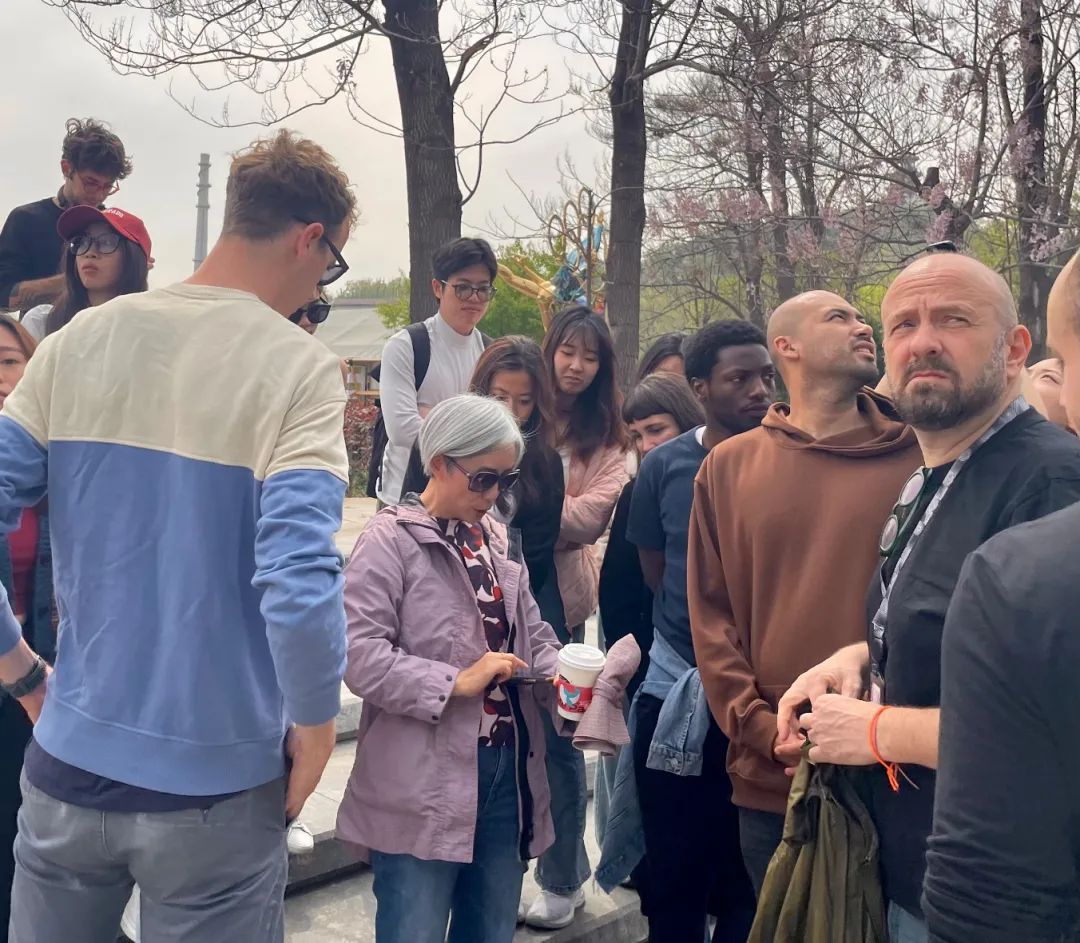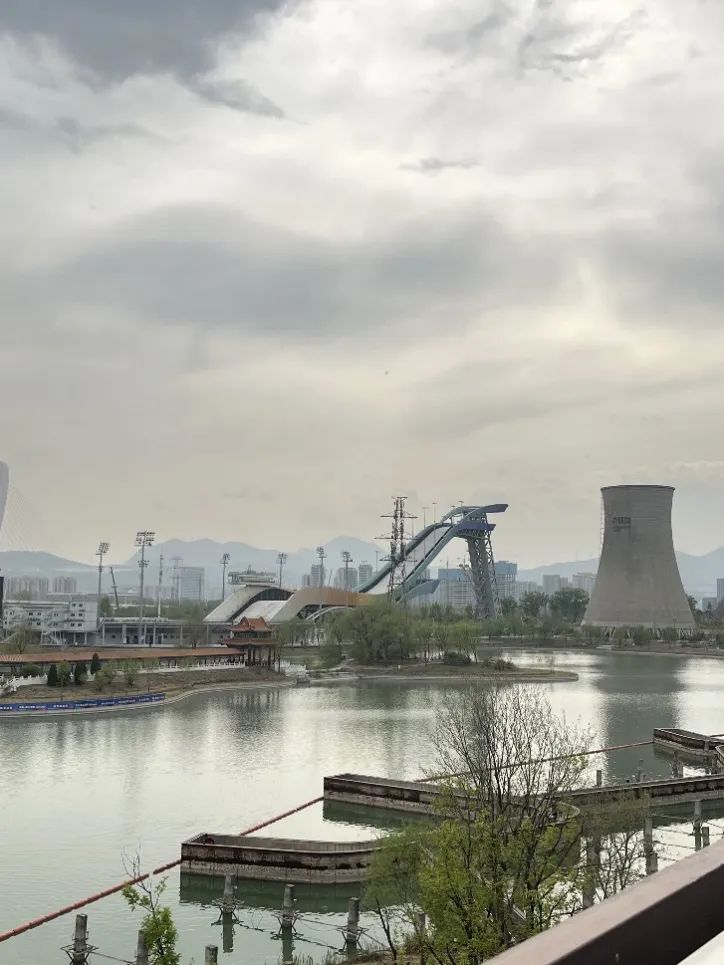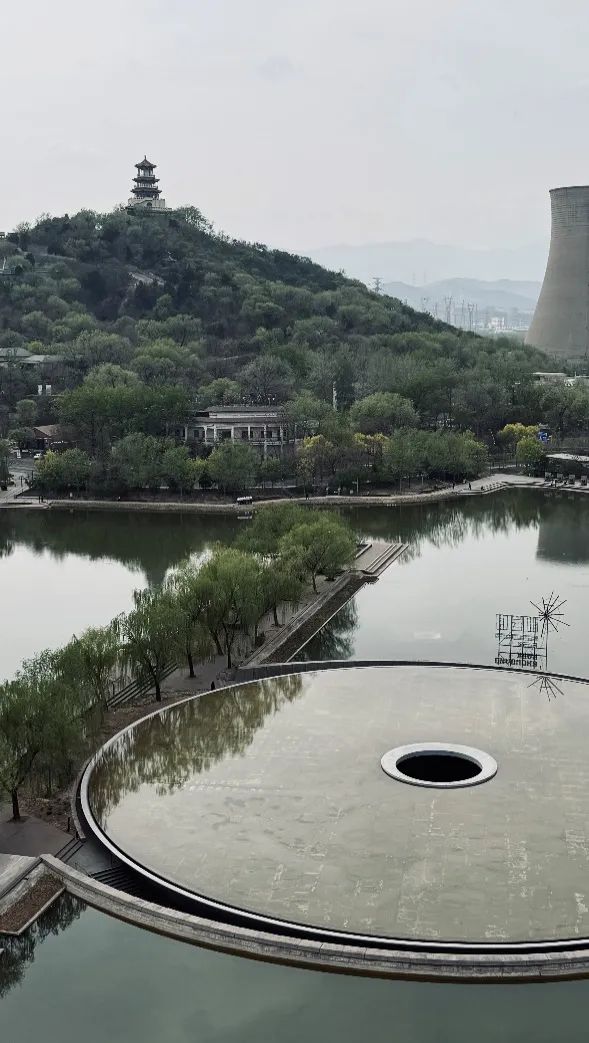2025年4月9日,清华大学建筑学院建筑学硕士英文项目(EPMA)2024级学生在课程教学安排下,前往北京首钢园进行实地调研,深入了解该区域在后工业时代背景下的城市更新策略与空间转型路径。
On 9 April 2025, students of the English Program for Master in Architecture (EPMA), Class of 2024, from the School of Architecture at Tsinghua University, conducted a field study at Beijing Shougang Park. The visit aimed to explore the urban regeneration strategies and spatial transformation of the area in the context of the post-industrial era.

首钢园原为北京市的重要钢铁工业基地,自2005年启动搬迁以来,通过工业遗产保护、功能置换与大型事件引导,逐步转型为集文化、生态、体育、商业等功能于一体的综合性城市公共空间。
Originally one of Beijing's major steel production zones, Shougang began its relocation in 2005. Since then, it has undergone a comprehensive transformation into a multifunctional public space integrating culture, ecology, sports, and commerce, guided by industrial heritage preservation and large-scale event planning.
在任课教师刘健教授的带领下,同学们依次参观了三高炉、北区六工会、群名湖、首钢高线公园以及香格里拉酒店等首钢园重要节点,现场感受工业遗存与当代设计理念融合的典范案例。
Under the guidance of Professor Liu Jian, the instructor of the course, the students visited key sites across the park, including the No. 3 Blast Furnace, North District Sixth Workers’ Union Hall, Qunming Lake, Shougang Highline Park, and the Shangri - La Hotel. They gained direct experience of exemplary projects where industrial heritage meets contemporary design thinking.

在三高炉区域,同学们了解了大型工业构筑物的再利用路径及其在文化创意空间中的角色转变,深入探讨如何在保留工业肌理的同时激活公共空间活力。At the No. 3 Blast Furnace site, students learned about the adaptive reuse of massive industrial structures and their transformation into cultural and creative venues. They also deeply discussed how to balance the preservation of industrial textures with the activation of public space vitality.

在北区六工会旧址,同学们观察了工业遗产中如何植入新的功能,通过空间组织与材料更新实现历史延续与现代融合。
At the former Sixth Workers’ Union Hall in the North District, students observed how new functions were integrated into existing structures. Historical continuity was achieved through spatial reorganization and material renewal, realizing the integration of history and modernity.
群名湖区域展示了首钢园在生态修复与景观再造方面的实践成果,湖区成为工业区转型后人与自然对话的重要界面。
The Qunming Lake area showcased the park’s ecological restoration and landscape renewal efforts. The lake area has become an important interface for dialogue between humans and nature after the transformation of the industrial area.


首钢高线公园作为园区最新的公共空间之一,依托原有高架皮带通廊打造空中绿廊,为园区提供了垂直维度的公共体验,也体现了“存量空间+绿色再生”的创新设计策略。
As one of the latest public spaces in the park, Shougang Highline Park creatively transformed the former elevated conveyor corridors into green pedestrian walkways. It provides a vertical public experience for the park and also embodies the innovative “stock space + green regeneration” design strategy.
最后,学生们参观了由首钢热力电厂改造而成的香格里拉酒店,项目保留原有结构体系,并以精致的室内设计回应钢铁建筑的粗犷美学,展现绿色可持续与工业记忆的深度融合。
The final stop was the Shangri - La Hotel, converted from the former Shougang power plant. The project retained the original structural system and used exquisite interior design to echo the rugged aesthetics of steel architecture, demonstrating the deep integration of green sustainability and industrial memory.
此次调研不仅增强了同学们对城市更新与空间再利用的认识,也深化了国际学生对北京城市发展演进、工业文化保护与绿色转型实践的理解。
This visit deepened students’ understanding of urban renewal and spatial reuse, and offered international students valuable insights into Beijing’s urban evolution, industrial heritage preservation, and green transformation strategies.
学生感想 | Students’ Feedback
Wong Wei Li 王维莉 (Malaysia)
去年我曾和朋友游览首钢园,但只是走马观花地欣赏工业风建筑。此次随老师参观首钢园,让我对这片工业遗址有了全新的认识。让我震撼的是首钢园对工业遗产的创造性改造,既保留了工业时代的厚重感,又注入了科技、文化与艺术的活力。首钢园的转型让我领悟到真正的城市更新,是在传承中创新,让历史与现代和谐共生。这次调研让我对工业遗产保护与城市可持续发展有了更深刻的理解。
Last year, I visited Shougang Park with friends, but we merely strolled through it. This time, visiting the park with our teacher gave me a completely new perspective on this industrial heritage site. What truly amazed me was the creative transformation of the park’s industrial legacy. It not only preserves the grandeur of the industrial era but also breathes new life into it through technology, culture and art. The transformation of the park made me realize that true urban renewal lies in innovating through heritage, allowing history and modernity to coexist in harmony. This field study deepened my understanding of industrial heritage preservation and sustainable urban development.
Wasin Hemachartwiroon 吴森 (Thailand)
作为城市规划课程的一部分,我有幸前往北京首钢园参观,这次经历让我深刻认识到了理论构想与现实世界中实际干预措施之间的联系。看到一座旧钢铁厂如何被改造为一个展现工业、文化与生态之间关系的城市空间,这非常有意义。这让我深入了解到在适应性再利用和可持续再生的理念中所存在的复杂层面。这次参观也进一步强化了一个重要的理念,即在保护旧场所的重要意义与接纳新发展或推动其演变之间实现平衡——这在城市更新项目中是一项重要的认知。我看到了建筑、景观和公共活动规划如何相互融合,重新塑造场所身份和空间营造,从而创造出一个具有凝聚力、包容性且多功能的环境。在这种情况下,走出课堂进行实地学习尤为重要,因为它加深了我对特定场地空间的理解,为我们在课堂上讨论过的一些既有规划概念增添了实际背景。实地参观一个地方还丰富了学术细节,因为它调动了感官,使我对城市区域形成了全面的认识。
Having the opportunity to travel to Beijing Shougang Park as part of an Urban Planning course opened my eyes to understanding the relationship between theoretical ideas and the implementation of interventions in the real world. It was valuable to see how an old steel plant was adapted into an urban place that communicates the relationship between industry, culture, and ecology, which gave me an insight into the layers of complexity that exist within the notion of adaptive reuse and sustainable regeneration. This trip also reinforced the important lesson of achieving harmony between preserving the significance of old places and accommodating or evolving to new developments—an important understanding in urban renewal project. I saw how architecture, landscape, and public programming can come together to re-imagine identity and place-making that generates a cohesive, inclusive, and multi-use environment. In this case, studying outside the classroom was particularly important, as it enhanced my understanding of space for a particular site, added context to several expired planning concepts we had discussed in lectures. Touring a place with field visits also enriches academic details because it appeals to the senses and forms a complete view of urban areas.
Adeliia Shaisultanova 戴丽 (Russia)
参观首钢园是一次鼓舞人心的经历,让我得以见证一个曾经的工业区是如何被重新构想,变成一个充满活力的城市空间。这个场地及其设施的庞大规模令我震惊——我从未见过如此大规模的棕地再开发项目。我们那次难忘的攀登三高炉之行,让我不禁思索这些工业建筑结构以及其背后的建造逻辑。而站在高炉顶部,那令人惊叹的景色映入眼帘:山上的一座宝塔和一个巨大的蓄水池。参观香格里拉酒店则进一步加深了我对这个场地的印象,它无疑是另一个成功的再开发项目。酒店大堂内绿意盎然,光线充足、空气流通,将原始的工业元素与现代材料无缝地融合在了一起。总的来说,老师的见解帮助我梳理了这些所见所闻,也凸显了实地考察在建筑学教育中无可替代的价值。
The visit to Shougang was an inspiring opportunity to witness how a former industrial zone had been reimagined into a dynamic urban space.I was struck by the sheer scale of the site and its objects—I've never seen a brownfield redevelopment of such magnitude.Our memorable climb to the ‘San Gao’ furnace left me pondering the industrial structures and the logic behind their construction, while the breathtaking view from the top revealed a pagoda on a hill and a vast water reservoir. The visit to the Shangri-La Hotel further deepened my impression of the site as another successful redevelopment project, where the lobby bursts with greenery and breathes with light and air, seamlessly merging raw industrial elements with modern materials. Overall, our teacher’s insights helped frame these observations and underscored the irreplaceable value of site visits in architecture education.
Hu Yue 胡玥 (Canada)
首钢园的实地调研让我对“空间再利用”有了新的理解。相比单纯的新建,这种基于工业遗产的更新保留了城市记忆,也创造了新的社会和文化价值。在参观过程中,我尤其被那些将旧结构转化为公共空间的设计细节打动,这种转变不仅是物理空间的改造,更是城市身份的重塑。此次经历让我思考建筑师在时代转型中的责任,以及我们在面对存量城市时应如何以创造性的方式回应未来的需求。
The field visit to Shougang Park reshaped my understanding of spatial reuse. Compared to buildings from scratch, this transformation grounded in industrial heritage preserves the city’s memory while generating new cultural and social value. I was especially impressed by how the old structures were thoughtfully converted into public spaces—this shift represents more than just a physical change; it is a redefinition of urban identity. This experience made me reflect on the architect’s role during times of transformation and how we can creatively respond to future needs within the context of existing cities.
Andrew Wilson 威尔柱 (United States)
在我们参观首钢园的过程中,我了解到了中国城市历史中两个有趣的方面:中国的历史工业遗产,以及像首钢园这样的场地在被改造成文化和商业园区时所采用的现代保护方式。这些地方通过为当地人和游客打造令人兴奋的体验式目的地,融入到了城市的肌理之中。这次参观中我最喜欢的时刻是我们爬上那座高大的高炉建筑,真切感受到了它的宏伟规模,同时还欣赏到了周围城市和山脉的壮丽景色。
During our visit to Shougang I learned about two interesting aspects of China's urban history — the historic industrial heritage of China, and the modern approach to preserving sites like Shougang as culture and commercial parks. These places fit into the urban fabric both by creating exciting experiential destinations for locals and tourists alike. My favorite moment from the visit was when we climbed the high furnace structure and got the sense of scale, and the spectacular views of the surrounding city and mountains.
Cristian Fernandez Yepez 欧阳磊 (Ecuador)
对首钢园区的实地考察极具价值,让我们得以亲身了解工业空间应如何改造,以实现可持续的城市未来。曾经污染严重的钢铁厂区如今变身为充满活力的公共文化中心,这一转变着实令人赞叹,堪称富有前瞻性的改造典范。与此同时,它也促使我们对工业转型所面临的更重大挑战进行思考。首钢园展示了城市如何将历史遗产与现代元素相融合,其成功也提醒着我们,钢铁、采矿等全球产业在经济增长与生态责任之间,仍存在尚未解决的矛盾。随着世界各地涌现出类似的项目,首钢园的故事不仅能为城市更新带来启发,还能推动重工业自身在实现更可持续发展方面进行更深入的创新,确保一个地方的发展进步不仅能为当地,也能为其他地区的问题解决贡献力量。
The site visit to Shougang District was incredibly valuable, offering firsthand insight into how industrial spaces can be reinvented for sustainable urban futures. The transformation of this once-polluted steel complex into a dynamic public and cultural hub is truly impressive—a model of visionary regeneration. At the same time, it invites reflection on the larger challenges of industrial transitions. While Shougang Park demonstrates how cities can harmonize heritage with modernity, its success also reminds us that global industries—like steel and mining—still face unresolved tensions between economic growth and ecological responsibility. As similar projects emerge worldwide, Shougang’s story could inspire not just urban renewal, but also deeper innovation in making heavy industry itself more sustainable, ensuring progress in one place contributes to solutions not just locally, but across borders.




